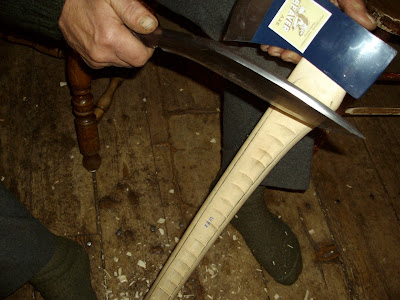Peter Vido wrote the following instructions for thinning existing axe handles.
The full post is at the Axe Connected blog:
http://axeconnected.blogspot.com/2011/03/thinning-handles.html
I should think that for most (if not all) ax users, thinning a piece of wood would be a straightforward task. The majority of the handles Ive thinned were done with a hatchet, and without drawing any guiding lines beforehand. But for the benefit of some beginners we will describe it step by step hence the notes on the proper procedure below.
As the first step, mark a line down the center of the whole handle on the narrow sides, both front and back. Then mark 2 lines parallel to it, again front and back. Each one of these should be half as far away from the center line as the intended thickness of the refined handle. (The woodworking beginners might give themselves a millimeter or two of grace and draw the line that much further away from the center.) The line should taper outwards 2-3 short of the end; this portion will taper gradually from knob (max thickness) to the average thickness of the whole to form the actual grip and ought to receive particular attention later in the process.
In the examples shown we opted for 20mm overall thickness (10mm to each side). That is still plenty heavy and will be further refined (thinned, though in portions of the handle only).
To remove the now clearly defined superfluous wood you have several options:
Using only a rasp is the most primitive, costly and time-consuming method, but it works and requires the least skill. (To rasp much off a hickory handle you had better have a good rasp; such rasps are not cheap and hickory wood dulls edges fast... but anyone can operate a rasp.)
The next most exact and safe method is to clamp the handle horizontally in a vice, saw down to the line at 1-2 intervals and then remove the wood with a chisel.
A faster option is a hatchet (or any other ax you can be reasonably accurate with) or if you are a khukuri knife user this can be the tool of choice.
I advise against the use of drawknives as a sole ax handle thinning tool (without the wood being first scored). The chance of catching a piece of wood and prying it away from the intended depth is too great unless youd be lucky enough to work on a handle with perfect grain, know how to recognize it before you start, and have enough experience using the drawknife for exacting work.
The rough wood removal is literally a 5 minute job. Simply score down to the lines. It is easier to concentrate on one line at a time, score every 2 or so and then place another sequence of score marks between the former ones, this time focusing on the other line. (Both of these lines, of course, represent one actual working side of the handle.)
Then remove the wood between score marks -- always from the opposite direction than the one they were placed from. (I do break this rule occasionally, but, being smart, you shouldnt...)
In these photos the use of khukuri knives -- the multipurpose tools of the Nepalese culture -- is shown. They work very well; in addition, these knives can serve the role of a drawknife, and for many tasks other than handle thinning (peeling bark, shaping/smoothing small rails, tipi poles, etc.)
A spokeshave is one option for smoothing after the hewing step. I usually use a rasp, followed by a 12 bastard file. When completely shaped the handle can be further finished with sandpaper, emery cloth or a small piece of broken glass/windowpane.
...













